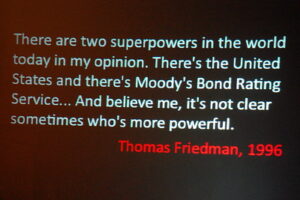I was reading an article about a bond refinancing opportunity for the Pulaski County Special School District. The PCSSD is located in the most populous county in Arkansas. Little Rock is the county seat. It offers an interesting perspective on reciprocal investments.
The PCSSD will be asking voters to refinance three current bond issues. Regardless of how residents vote, their taxes will not change. In that respect, there’s nothing in this for them. On the other hand, allowing the PCSSD to refinance their bond issues will make more money available to the school district for infrastructure projects. And when I say “more money,” I mean $80M.
That sum would allow PCSSD to expand and modernize high school and elementary school buildings to enable more students to attend. It would also allow the district to improve athletic facilities at one high school to make it comparable to the district’s other high schools. Still another high school would receive a multipurpose facility. The district would also use funds to bring other buildings up to code and add instructional technology to the district’s elementary schools. All district buildings would receive lighting upgrades. The district estimates that conversion to LED lighting would reduce its annual electricity consumption by one-third. PCSSD would also build a new transportation facility for the district’s school buses.
Enrollment is growing in the district and the improvements would ensure that the district can accommodate enrollment growth. In other words, it will allow the district to make reciprocal investments in the community. District Superintendent Dr. Charles McNulty said,
“When we add to our public schools, it does help the asset values of the neighborhoods around it, it helps both our community, our students, our stakeholders and those who don’t go to public schools.”
WCC doesn’t believe in reciprocal investments
It’s an interesting notion. The community invests in the school district; the school district responds by making reciprocal investments that enhance the community.
McNulty went on to say that the district had built a lot of infrastructure, but that it was not always well-planned. To correct that, PCSSD had developed a master plan that identified both deficiencies and corrections.
Their master plan took into account how the school district’s investments would generate returns in the communities it serves.
WCC recently released its Master Plan. The WCC Master Plan was very focused on WCC, and what it would cost the community to make the Master Plan happen for WCC. It didn’t contain much about how the Master Plan was going to return that investment to the community. The only return we receive on our investment in WCC is ill-maintained buildings, risky bond debt, and a badly bloated College administration.
WCC’s Master Plan is filled with largely cosmetic changes to the campus. It doesn’t contain any information about new educational programs or new academic facilities. It does contain some ridiculous pap about bringing the public in to the “retail outlots” on campus. From a security perspective, do you really want people who have no legitimate reason to be on campus dropping by to do a little shopping?
A magnificent community college that focuses on its mission improves the community around it. A community college that makes building a Starbuck’s in the parking lot one of its highest priorities does not.
Photo Credit: QuoteInspector.com, via Flickr




















